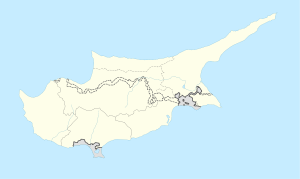Polis Chrysochou
| Polis Chrysochous | ||
|---|---|---|
 |
||
|
||
| Location in Cyprus | ||
| Coordinates: 35°2′0″N 32°26′0″E / 35.03333°N 32.43333°ECoordinates: 35°2′0″N 32°26′0″E / 35.03333°N 32.43333°E | ||
| Country |
|
|
| District | Paphos District | |
| Government | ||
| • Mayor | Angelos Georgiou | |
| Population (2011) | ||
| • Total | 3,690 | |
| Time zone | EET (UTC+2) | |
| • Summer (DST) | EEST (UTC+3) | |
Polis (or Polis Chrysochous; Greek: Πόλη Χρυσοχούς or Πόλις Χρυσοχούς; Turkish: Poli) is a small town at the north-west end of the island of Cyprus, at the centre of Chrysochous Bay, and on the edge of the Akamas peninsula nature reserve. It is a quiet tourist resort, the inhabitants' income being supplemented by agriculture and fishing.
Polis is served by the fishing port of Latchi. Polis is close to the beautiful Akamas peninsula, a nature reserve.
Marion (the original name of Polis) was already inhabited at the end of the Neolithic and through the Chalcolithic period. It began to prosper from the Cypro-Archaic period onwards and became one of the most important ancient Cypriot city—kingdoms in the Cypro-Classical period with important commercial relations with the East Aegean islands, Attica and Corinth. In 312 BC, it was conquered by Ptolemy I and the kingdom was abolished until its reconquest by Ptolemy II Philadelphus who renamed the city after his sister and wife. The new city was smaller than Marion but it also flourished due to its close proximity to the copper mines.
In Egypt at Medinet Habu in the temples of Ramesses III, there is a large 12th-century BC inscription which refers to Cyprus. The names of Cypriot towns mentioned include Marion. However, the first definite reference to Marion occurred in 449 BC, when the city, as indeed other city-kingdoms of Cyprus, was under Persian rule. During that year, Kimon, the great Athenian general, freed the city from the Persians. Later, the ancient geographers spoke of the town as "Marion Ellinikon"—The Hellenic Marion. The Kingdom was rich in gold and copper ore, mined chiefly in the nearby Limni Mines. It was the natural wealth which led the city to a period of flourishing trade, especially with Athens, which in its turn, exported many Attic pots to Marion. Samples of this pottery can be viewed at the Polis Archaeological Museum.
...
Wikipedia


